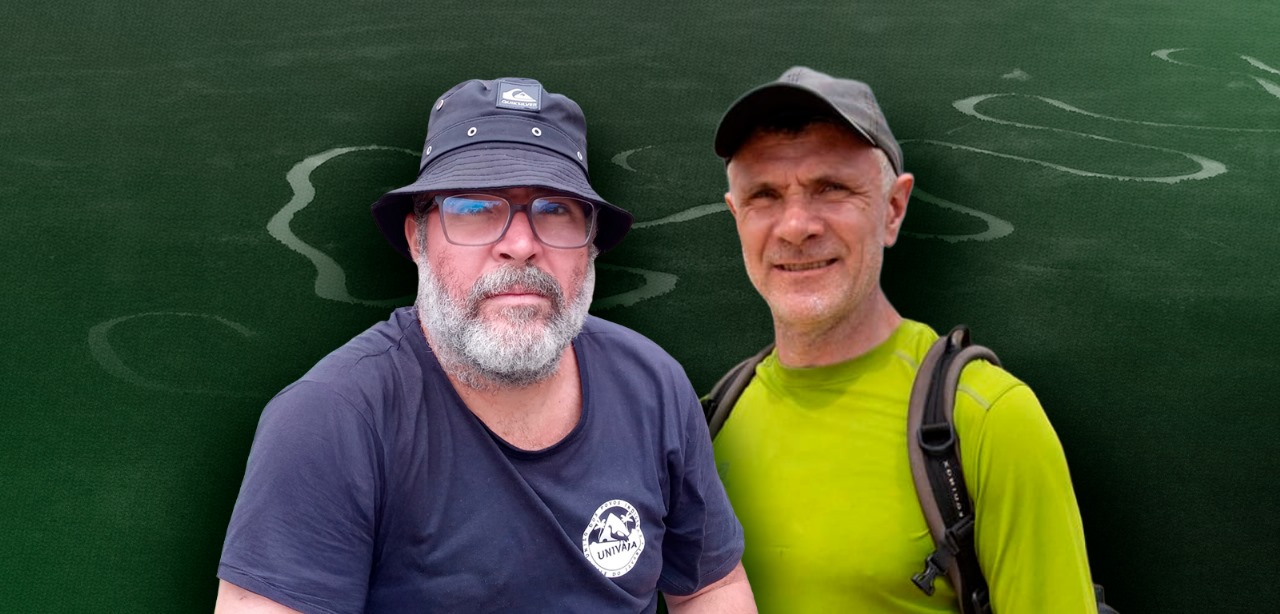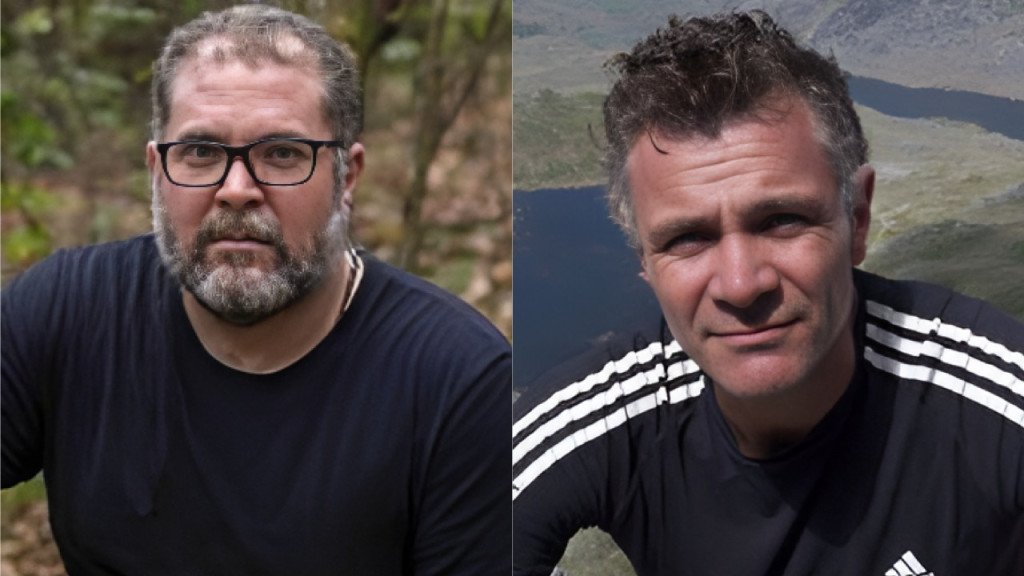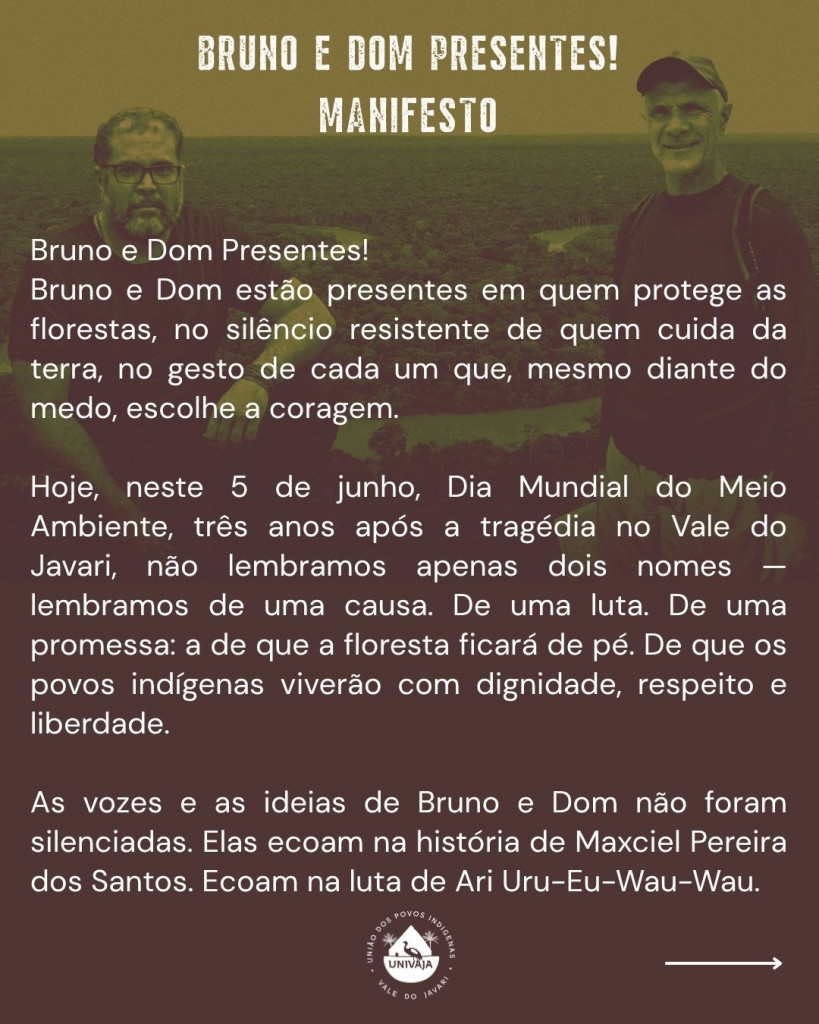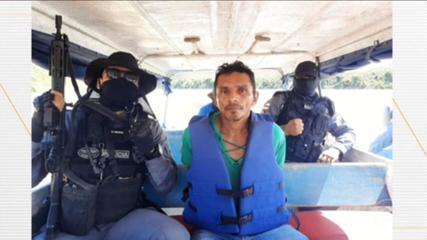‘They were not silenced,’ says indigenous union remembering the 3 years since the deaths of Bruno and Dom
05 de June de 2025

By Ana Pastana – From Cenarium
MANAUS (AM) – The Union of Indigenous Peoples of the Javari Valley (Univaja), along with 49 organizations, journalists, and public figures, released this Thursday, June 5, a manifesto in memory of indigenist Bruno Pereira and British journalist Dom Phillips in Amazonas, who were murdered on June 5, 2022. The deaths mark three years.
The “Manifesto – Three Years Without Bruno and Dom” recalls the date that marks the disappearance of Bruno Pereira and Dom Phillips near the Javari Valley Indigenous Territory, in the municipality of Atalaia do Norte, 1,136 km from Manaus, Amazonas, while they were conducting an investigation in the region.

Three years ago, on June 5, 2022, the local, national, and international press reported on the disappearance and, days later, the discovery of the bodies of Bruno and Dom. According to the investigation by the Federal Police (PF), both were killed in retaliation for the environmental inspections Bruno conducted in the Javari Valley region.
According to the manifesto, Bruno and Dom remain present in those who protect the forests, in the resistant silence of those who care for the land, and in the actions of those who, even in the face of fear, choose courage.
“Today, this June 5, World Environment Day, three years after the tragedy in the Javari Valley, we do not remember only two names — we remember a cause. A struggle. A promise: that the forest will remain standing. That Indigenous peoples will live with dignity, respect, and freedom,” reads an excerpt of the manifesto. (See the full manifesto below)
The document mentions other environmental defenders murdered in the Amazon: “The voices and ideas of Bruno and Dom were not silenced. They echo in the story of Maxciel Pereira dos Santos. They echo in the fight of Ari Uru-Eu-Wau-Wau. In the faith and bravery of Dorothy Stang. In the living memory of Emyra Wajãpi, Mother Bernadete, Chico Mendes, and so many others who died fighting.”

The manifesto demands protection for the “guardians of the forest,” recalling that the country is hosting the 2025 United Nations Climate Change Conference (COP30) this year. “This year, as Brazil prepares to host COP30, the world is watching us. And we demand more than promises. We demand protection for the guardians of the forest. We demand real, urgent, and transformative actions,” the document states.
Finally, the organizations, journalists, and public figures stress that Bruno Pereira and Dom Phillips are present “in every free word, in every courageous report, in every act of resistance, in every defense of democracy, human rights, and press freedom.” The document ends by affirming that they are remembered with pain but also with pride, and that what they did was not in vain.
Understand the case
Journalist Dom Phillips arrived in the municipality of Atalaia do Norte in early June 2022 with the aim of interviewing Indigenous leaders and traditional peoples of the region for a long-form journalistic book he was producing. This was not the first time Phillips had visited the area.
Indigenist Bruno Pereira was a former employee of the National Foundation for Indigenous Peoples (Funai). He had been on leave from the agency since early February 2020 and was a career official at the foundation but had been dismissed from the General Coordination of Isolated and Recently Contacted Indigenous Peoples four months before the crime.
Leading projects that aimed to guarantee the rights of communities and protect their territories and natural resources, the indigenist had received multiple death threats, which were formally reported to the Federal Public Prosecutor’s Office.
The murder
On June 3, 2022, Bruno and Dom left the municipality of Atalaia do Norte using a motorboat belonging to Univaja to meet with leaders from five communities located outside the Indigenous territory. After fulfilling their commitments, the pair left on the morning of June 5, heading to the São Rafael community, where Bruno was to meet with the community leader known as “Churrasco (Barbecue).”
According to information provided to the press at the time, for safety reasons, Bruno always notified Univaja in advance of any movements he planned to make. On that day, he and Dom planned to travel about 72 kilometers, roughly two hours of navigation, which never occurred.
Bruno and Dom disappeared shortly after being seen near the São Gabriel community, a neighboring village to São Rafael, the last place the pair were known to have visited. After hours without contact, Univaja deployed nearby teams to begin searching for Bruno and Dom.
The investigation
Ten days after the disappearance, federal police located “human remains” at a remote site indicated by Amarildo da Costa Oliveira, known as “Pelado (Naked),” who had been detained on the 7th of that month after the Amazonas Civil Police (PC-AM) identified him through witness statements. He was the first suspect to be identified at the time. Two days later, PF forensic experts confirmed that at least some of the human remains found belonged to Bruno and Dom.

Initially, Pelado denied involvement in the disappearance of Bruno and Dom, but in addition to testimonies from people who said they had seen him threaten the journalist and the indigenist, PF forensic experts identified traces of blood in the boat he used on the day the pair disappeared.
Bruno was killed with three shots, one of them in the back, with no chance of defense. Dom was murdered solely for being with Bruno, in an attempt to ensure impunity for the prior crime.
Given the evidence, Pelado ended up admitting to participating in the murders and the concealment of the indigenist’s and journalist’s bodies, pointing to the location where the bodies were buried. This led to the arrests of Pelado’s brother, Oseney da Costa de Oliveira, known as “Dos Santos,” who was detained on June 14, and to the issuing of an arrest warrant for Jefferson da Silva Lima, known as “Pelado da Dinha,” who turned himself in to the Civil Police in Atalaia do Norte four days later.
Conclusion
The Federal Police investigation, which lasted more than two years, resulted in the indictment of nine suspects. According to the final report, the PF identified the mastermind of the crime as Ruben Villar, known as “Colômbia,” stating that he financed and provided resources, including ammunition, for the double homicide.
Additionally, according to the police, he coordinated the concealment of the bodies of Bruno Pereira and Dom Phillips. The other suspects were involved either directly in the execution of the murders or in hiding the victims’ corpses.
The investigation also exposed the operations of a criminal organization in the Atalaia do Norte area, connected to illegal fishing and hunting activities, which directly impact the environment and Indigenous populations in the region.
Amarildo and Jefferson confessed and provided details about the crime in their initial statements to the police and the court, which were confirmed by witnesses and the evidence in the case files.
According to the Federal Public Prosecutor’s Office (MPF), there was already a history of disputes between Bruno and Amarildo over illegal fishing in Indigenous territory. The motive for the murders was allegedly Bruno asking Dom to photograph the accused’s boat.
The MPF also appealed to the Superior Court of Justice (STJ) for one of the three men accused in the murders of Bruno and Dom to be taken to a jury trial. The appeal to reconsider the decision of the Federal Regional Court of the 1st Region (TRF1), which favored Oseney da Costa de Oliveira, was filed in January of this year.
According to the MPF’s argument, witnesses heard during the process placed the fisherman at the crime scene. Investigations showed that Oseney met with his brother, Amarildo da Costa de Oliveira, on the day and time of the murders. The agency also mentioned that Jefferson da Silva Lima confessed that Amarildo had summoned his brother and other relatives to go after Bruno Pereira.
For the MPF, Oseney was involved in the crime and should be judged by a jury, just like the defendants Amarildo and Jefferson, who are charged with double qualified homicide and concealment of a corpse. The agency argues, through the Regional Prosecutor’s Office of the 1st Region (PRR1), that the TRF1 decision violated Articles 413 and 414 of the Code of Criminal Procedure (CPP), as there is sufficient evidence to justify Oseney’s trial by jury.
Amarildo and Jefferson will be tried for double qualified homicide and concealment of the victims’ corpses. Both remain in custody. As for Oseney, he awaits the conclusion of the case under house arrest with electronic monitoring.

